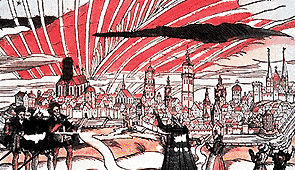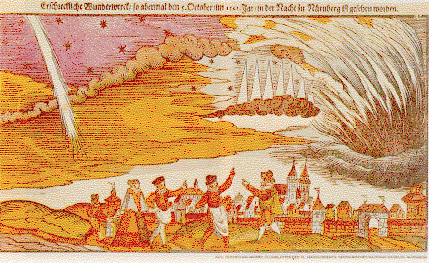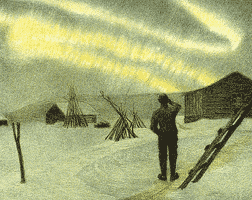Folklore
The
Mysterious Northern Lights
From
time the people of the North have stopped their daily routines, their thoughts
either hounded by fear or drawn to inspiration, as the flaming diversity of the
Northern light filled the sky. Its
fluttering draperies, every colour of the spectrum, suggested the presence of
dancing spirits and fighting hoards.
 The idea of dancing was not uncommon
amongst the ancient Norwegians. In
western Norway a belief, which existed even up to fairly recent times, was that
the northern light were “old maids” who were dancing and waving white
mittens. In these areas people
actually thought that elderly unmarried woman would go to the northern lights
after they died. Similar notions
about the northern lights can also be found in Finland.
The idea of dancing was not uncommon
amongst the ancient Norwegians. In
western Norway a belief, which existed even up to fairly recent times, was that
the northern light were “old maids” who were dancing and waving white
mittens. In these areas people
actually thought that elderly unmarried woman would go to the northern lights
after they died. Similar notions
about the northern lights can also be found in Finland.
In
many parts of Scandinavia it was thought that the northern lights were something
to do with virgins. The Sami
(Lapps) are said to have sung the following jingle about girls and unmarried
woman when they saw the northern lights:
Girls,
girls run around the fireplace
Dragging their pants behind them.
In
Nordic countries the lights were also regarded as being especially dangerous for
woman, who were advised to say inside while the lights rampaged the sky.
They had to be particularly careful not to go out bare-headed, for if
they did the northern lights might come out and tear their hair out!

In
Scotland the expression “The Merry Dancers” is well known as a name for the
northern lights. According to
legend, these “merry dancers” are supernatural beings warring in the
heavens, and the battle is for the favour of a beautiful woman.
For
the Eskimos of Greenland and Hudson Bay in Canada, the northern lights
represented the home of their ancestors. When
the northern lights flickered, the Greenlanders thought that dead wished to make
contact with their living kith and kin. The
Eskimos had great respect for their ancestors and therefore the northern lights
were not blasphemed.
Amongst
North American Indian tribes it was believed that the northern light were a
gathering of medicine men and warriors in the land of the far north.
They held feasts and prepared their fallen foes in huge cooking pots.
Other Indians thought that the ice furthest to the north, several days
journey away, dwelt a tribe of tiny Indians who were so strong that they could
catch whales with their bare hands.
Another
common theory amongst our forefathers was that the northern lights were a kind
of fire. In Denmark and Sweden it
was thought that the northern lights were an active volcano in the north, placed
there by the creator to provide light and warmth in those cold, murky regions.
Their were also those in Sweden who thought that the northern lights were
caused by Sami searching for their reindeer with flaming torches.
Amongst
the Ostyaks fishing was a daily routine. For
this Siberian race, the northern lights were a flame kept burning by the fish
god to help those who were fishing after dark.
One
of the most romantic concepts regarding the northern light is found in Danish
folklore. Here it was thought that
they were caused by some swans which had flown too far north and become frozen
in the ice. As they flapped away
trying to free themselves, reflections from their wings would create the
northern lights.
The
Northern Lights-a Vengeful Body
The majority of peoples
regarded the northern light with fear. The
Eskimos of Alaska, for example would take their children in doors when the
northern lights appeared. If the
children did not get inside quickly, it was believed that the northern lights
would come and take their heads to use as balls.
For the Faeroe Islanders too, the northern lights represented a threat to
their children’s health and well-being. They
were not to go outside bareheaded or the northern lights would strike and singe
their hair off.
In Iceland pregnant woman
were not supposed to go out in the northern lights, for if they did, the child
that they were carrying would be born cross-eyed.
Over large areas of the country it was a common believe that the northern
lights were a vengeful body that would kill those who mocked them.
One way of mocking was to wave white clothing at them.
Another well-known tradition
in both south and north Norway was the fear of whistling at the northern lights.
This fear is undoubtedly associated with beliefs in other northern
cultures that the northern lights were the resting place of the dead, and that
the dead could be contacted by whistling.
 The idea of dancing was not uncommon
amongst the ancient Norwegians. In
western Norway a belief, which existed even up to fairly recent times, was that
the northern light were “old maids” who were dancing and waving white
mittens. In these areas people
actually thought that elderly unmarried woman would go to the northern lights
after they died. Similar notions
about the northern lights can also be found in Finland.
The idea of dancing was not uncommon
amongst the ancient Norwegians. In
western Norway a belief, which existed even up to fairly recent times, was that
the northern light were “old maids” who were dancing and waving white
mittens. In these areas people
actually thought that elderly unmarried woman would go to the northern lights
after they died. Similar notions
about the northern lights can also be found in Finland.
